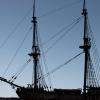-
Posts
1,171 -
Joined
-
Last visited
Reputation Activity
-
 jud got a reaction from NMBROOK in Anyone ever cast their own cannon?
jud got a reaction from NMBROOK in Anyone ever cast their own cannon?
You can melt aluminum, if memory serves at about 1300°F, iron and brass is about 2100°F.. You can get a pot of aluminum to liquify by using charcoal or gas as a fuel, the web has much info on sand molding and furnaces. You are thinking along the same lines as myself about casting the guns, using castings you can cast the trunnions in, that is a big plus to me. What is running around the back of my mind is casting them using the lost wax method, maybe I will need to go to the art department at some college, that does bronze figures, they probably use induction furnaces.
jud
-
 jud reacted to wefalck in Holy-stoning (Moved by moderator)
jud reacted to wefalck in Holy-stoning (Moved by moderator)
I am quite sure that all decks on which people lived where scrubbed in one way or another for hygienic reasons, though bacteria etc. at the time of sailing ships were not recognised yet. For the same reason, sides and ceilings where white-washed. The lime solution has a very high pH and acts as a mild bactericide.
wefalck
-
 jud reacted to Ulises Victoria in The Kit-Basher's Guide To The Galaxy
jud reacted to Ulises Victoria in The Kit-Basher's Guide To The Galaxy
MOSQUITO MESH AND CLEAR ACETATE: To make windows.
-
 jud got a reaction from WackoWolf in Frames vs Bulkheads
jud got a reaction from WackoWolf in Frames vs Bulkheads
It is free choice and what the individual preference is, guides the choice of methods.
jud
-
 jud got a reaction from avsjerome2003 in Household Ammonia
jud got a reaction from avsjerome2003 in Household Ammonia
Would an application of linseed oil bring the life back. Used it on a foot long birch bark canoe model that some relatives had acquired in the early 1900, it was badly dried out and brittle, the linseed oil brought it back. I use it on outdoor tool handles and it darkens the ash handles.
jud
-
 jud got a reaction from Jay 1 in Name the Ship Game
jud got a reaction from Jay 1 in Name the Ship Game
Wouldn't have something to do with a hippie stranded on an island would it?
jud
-
 jud reacted to bizibilder in Cutting/Sanding Brass?
jud reacted to bizibilder in Cutting/Sanding Brass?
Files are the tools to use for shaping and finishing brass (or other metals). Abrasive papers are really only for finishing and polishing.
A useful trick when making small brass parts is to leave them attached to the "parent" stock so that you have something to hold whilst working on them. Sometimes with pre-made parts, especially if they are very small, it could be worth soldering them to a big "holding piece" to work on them (or epoxy/glue/tape them if you don't like soldering). When complete you can un-solder them (or break the epoxy bond) and file them clean before you use them on your model.
-
 jud got a reaction from JerseyCity Frankie in How to fasten a line to a belaying pin on a real ship and model.
jud got a reaction from JerseyCity Frankie in How to fasten a line to a belaying pin on a real ship and model.
The loop over the pin would be a guide on which side should be up if dropping the coil on deck, get the wrong side up and what a tangled weave we would make, get the right side up and the line would run off the coils without kinks or twisting.
jud.
-
 jud got a reaction from WackoWolf in Finding cannons available for large scratch build scales
jud got a reaction from WackoWolf in Finding cannons available for large scratch build scales
Bill check out the arts departments of your local Universities and Collages, many teach bronze casting, along with having a lab equipped to do small runs. They usually will work with people needing castings and because your ship building can be considered an art they should be friendly. Might even work out some trading, offer to make some presentations of your work and techniques.
jud
-
 jud got a reaction from Bill Hime in Finding cannons available for large scratch build scales
jud got a reaction from Bill Hime in Finding cannons available for large scratch build scales
Bill check out the arts departments of your local Universities and Collages, many teach bronze casting, along with having a lab equipped to do small runs. They usually will work with people needing castings and because your ship building can be considered an art they should be friendly. Might even work out some trading, offer to make some presentations of your work and techniques.
jud
-
 jud got a reaction from Bill Hime in Finding cannons available for large scratch build scales
jud got a reaction from Bill Hime in Finding cannons available for large scratch build scales
If you cast them, cast them with trunnions. You could make the patterns and take them to a foundry that will cast in brass or a malleable bronze. The foundry castings would allow you to, after drilling the bores, to load and fire the things, a filament ignition device should be easy to make. Why have guns, if you can't shoot the things?
jud
-
 jud got a reaction from kiwiron in HMAT Supply by Kiwiron - FINISHED - Caldercraft 1/64
jud got a reaction from kiwiron in HMAT Supply by Kiwiron - FINISHED - Caldercraft 1/64
Looks good and shows the care and time put into the build. Only have one thing that bothers me, probably only me only because of my having been a Gunners Mate in the Navy and kind of a gun nut by nature. Your guns do not have enough room to work them or allow for recoil, might be because the guns provided were the wrong scale and or the Cargo Hatch is to wide. Most won't notice. I was once ordered to fire a loaded gun, knowing it would recoil into a locked loader tray. Used a stinger hooked up to the another guns firing circuit, fired the gun while taking shelter in my helmet. It recoiled into the tray, parts went everywhere and the gun was down for about 3 months. Repaired it in place, when it should have been replaced. I was the safety observer, so I didn't get to leave, like the Fleet Marine gun crew did. Yep, I always consider recoil when I see a crew served gun. My observation only, it does not detract from the quality of your build.
jud
-
 jud reacted to Script in Ratlines....why so important.....
jud reacted to Script in Ratlines....why so important.....
Frankie,
I think they stopped using ratlines so the rats were easier to catch if anyone wanted a snack...........
-
 jud reacted to Jim Lad in Name the Ship Game
jud reacted to Jim Lad in Name the Ship Game
Jud,
Hang off one anchor, break the cable, get a line attached to the cable outside the hawse pipe, pass the end of the cable around the other until it's clear, heave the cable back into the pipe and re-connect the cable, heave up both anchors. (I think I've remembered it correctly).
John
-
 jud got a reaction from dafi in Why do hot guns jump violently?
jud got a reaction from dafi in Why do hot guns jump violently?
Call the Mythbusters! Sounds like a good plan. How does one get that in the pipe?
jud
-
 jud got a reaction from Jay 1 in Mystery Gun: Anyone know what this is?
jud got a reaction from Jay 1 in Mystery Gun: Anyone know what this is?
Jay, thanks for the links, never ran into that gun, before my time. I was looking at the posted picture, trying to determine what kind of breach it had, because of the compactness, I was thinking it must be an Interrupted Thread System, your link bore that out and also showing that it used fixed ammunition. Be kind of neat to get a hands on look.
jud
-
 jud got a reaction from Senior ole salt in Why do hot guns jump violently?
jud got a reaction from Senior ole salt in Why do hot guns jump violently?
We were not dealing with cast iron and an unloaded hot gun was not attacked with buckets of seawater, we would have used hoses. Destroying a hot barrel with copious amounts of sea water would only be done to attempt to prevent an explosion in the bore, caused by heat cooking off the explosives in the projectile. If a projectile could not be removed from a hot gun, the cooking off of the projectile was a real danger. Hot guns and explosive projectiles spending much time in them are dangerous, a propelling charge cooking off was not desired but not as dangerous, it would just clear the bore. I have experienced misfires in hot guns, was successful in re-cocking the firing pin and lucky enough for the round to fire. I have also attempted to re-cock and attempted to fire unsuccessfully with warm guns, waited 30 minutes to avoid the possibility that it was not a miss-fire but a hang fire instead, then opened the breach and extracted the round from the chamber, always a nervous time. First time I experienced a miss fire as Mount Captain was on a 3" 50 aboard a Heavy Cruiser, I cleared the mount as instructed but I remained with the gun, the Warrant Gunner came up to the gun and we waited our 30 minuets then I very carefully opened the breach, caught the rear of the case and worked it clear of the loader and handed it to the gunner. Horror of Horrors, he upended that round, thumped the primer with his finger and tossed the round overboard while saying defective primer, "even throwing a live round overboard required that the round hit the water case down, if it hit projectile down and the propellent went off, the case would act as a rocket and come back, case down prevented that". Never needed to hose down a hot gun but was prepared to do so quickly if needed. Closest to a projectile exploding in a bore was in RVN, firing old WW 2 ammo while supporting PBR's in a firefight. Just firing the right gun of a water cooled twin 40 MM, after about 20 rounds the gun made more of a cough than a bang, recoil was short and the projectile blew up just clear of the bore, the shrapnel dispersed in a half moon shape ahead of the gun, none came back towards us that we knew about. The gun quit working so I shifted to the left gun and resumed firing, that kept the rounds going out and didn't allow the loaders to get rattled. When I had time I investigated and found a split cartridge case and broken extractors in the gun, replace the extractors and that gun was up and working. The smoke that the propellent of that round produced was a rotten smell unlike the norm.
I still do not believe that the guns of old, jumped when fired as designed, I have fired to many guns to believe that. Black powder and smokeless powder do have different burning rates under pressure, but neither stay in the bore of a hot gun long enough to change the characteristics of their burn rates. If a gun starts to appear to jump as it warms up, it is because of outside forces or conditions having an effect on normal recoil. There is a reason why no one has came forward with a scientific explanation of jumping guns, that is because there is none. Trails on field guns will work their way deeper on each firing unless they are re fired from the position reached at the end of recoil, but the practice was to push them back into battery, that recoil and pushing back into battery would disturb the ground, the trails would be deeper and in soft ground the wheels would be worked deeper and deeper into the ground. Aboard ship the jumping would destroy the wooden wheels and tear up the deck as well as pulling the breaching and its rings out of the bulkhead, carronades would destroy their mounting platforms. Think there is a model of a small boat on this site, with a cannon mounted with a track built into the boat to allow the working of the gun and free recoil, If it was normal for guns to jump, they would not be staying in those tracks.
Kind of a windy post, I will not be insulted or distressed if the Moderators choose to remove it, may do it myself later.
jud
-
 jud got a reaction from dafi in Why do hot guns jump violently?
jud got a reaction from dafi in Why do hot guns jump violently?
I have been Mount Captain or a crew member of crew served guns from 40 mm Bofers up to 8"55 bagged powder type guns, that experience and logic influences my belief that jumping guns was not normal, hot or cold..
You do not go to all the trouble to place a gun crew and it's gun in harms way to have their gun maim or kill the crew while firing of the gun, as it was designed. The people who maned those ships were the same species as us, same brain and the same ability to adapt and use what they had available to them in a productive way, they weren't stupid enough to, by design of the gun or to allow the loading of a propellent charge that would cause their guns to jump out of control, hot or cold.
War ships of those days only existed to transport the guns and their crews to the firing line, when they did get there, hopefully well trained, those in charge did not want any surprises, such as having their guns change their characteristics because of heat. The rate of fire of those guns could not have gotten hot enough to change the powders characteristics, if the gun got that hot, there would be danger of the propellent cooking off before the shot was rammed home.
I don't believe the guns jumped under their normal designed use. There are ways that could cause a gun to jump, but by doing those things, you were stepping outside the norm.
jud
-
 jud got a reaction from realworkingsailor in Why do hot guns jump violently?
jud got a reaction from realworkingsailor in Why do hot guns jump violently?
I have been Mount Captain or a crew member of crew served guns from 40 mm Bofers up to 8"55 bagged powder type guns, that experience and logic influences my belief that jumping guns was not normal, hot or cold..
You do not go to all the trouble to place a gun crew and it's gun in harms way to have their gun maim or kill the crew while firing of the gun, as it was designed. The people who maned those ships were the same species as us, same brain and the same ability to adapt and use what they had available to them in a productive way, they weren't stupid enough to, by design of the gun or to allow the loading of a propellent charge that would cause their guns to jump out of control, hot or cold.
War ships of those days only existed to transport the guns and their crews to the firing line, when they did get there, hopefully well trained, those in charge did not want any surprises, such as having their guns change their characteristics because of heat. The rate of fire of those guns could not have gotten hot enough to change the powders characteristics, if the gun got that hot, there would be danger of the propellent cooking off before the shot was rammed home.
I don't believe the guns jumped under their normal designed use. There are ways that could cause a gun to jump, but by doing those things, you were stepping outside the norm.
jud
-
 jud got a reaction from dafi in Why do hot guns jump violently?
jud got a reaction from dafi in Why do hot guns jump violently?
In guns the heat is produced in the bore and chamber, it radiates outward rapidly, ever see the paint on a large weapon burn because of that heat or a small arms barrel burn the oil, the heat generated does not remain where it was created? Don't think that the bores of muzzle loading cannons get smaller with heating, there is enough time for any heat to radiate out between shots, which would allow for a constant temperature in the whole gun tube. The slow firing rates of muzzle loading guns allows for some cooling time between each shot and the wet swab will add some cooling water, a side benefit of drowning burning embers. I would not be surprised to find that the heat those old cannons had to deal with, would be considered cool in modern rapid fire guns. Nor do I believe that those guns were allowed to jump around under normal use, recoil was a factor, provisions were made to control the effects of that.
I don't know how the gun tackle was handled, was it thrown off or allowed to run with recoil acting a brake. Were it allowed to run, any slack in those tackles would tend to destroy that tackle when the gun was fired and if the slack was controlled and the tackle allowed to run, there would be a bitter end whipping around. Need to find some gun drill instructions written at the time to answer that. Perhaps someone here has read some gun drill instructions that could shed some light about what was done with the tackle when the gun was actually fired.
jud
-
 jud got a reaction from dafi in Why do hot guns jump violently?
jud got a reaction from dafi in Why do hot guns jump violently?
Need to keep in mind that the object of firing a gun was to maim or kill your opponent, not your own gun crews. Injuring your crews or blowing up your guns would be counter productive and everyone knew that. Because powder cartridges were made up in the powder rooms and taken to the guns one at a time, we know much thought went into the preservation of the ship, its gun crews and its guns. It is reasonable to assume that if a hot gun produced excessive pressure because of a heated propelling charge, that would have been taken into consideration when the powder charges were measured and made up into a powder cartridge. I know that their powder was regularly tested for the energy it would produce, the devices were kind of like a pistol of the time but instead of propelling a projectile, the pressure generated was measured by how far a hinged but restricted paddle was moved by each measured charge, crude but would detect changes in the conditions of the powder. Black powder has more in common with blasting chemicals used today than smokeless powder, in fact black powder was used as an explosive. Double shoting was not uncommon, that would produce greater recoil with the standard charge and move the gun to the full limits of the breaching ropes at a higher speed than normal and cause a jump, another thing that might allow that recoil to appear greater in a hot gun, could be, the axles and wheels would smooth out and offer less friction as they were used.
I was a Gunners Mate in the Navy for about 8 years and have fired thousands of rounds, small arms up to 8" 55's, safety was always taken into account, even in combat. Those safety rules were said to have been written in blood, I question that those ship cannons were intended to jump around when fired normally. It is normal for guns to get hot when being fired repeatably, so I can't believe that a hot gun was not taken into account and the proper safe charges were not worked out long before those guns were placed on any Navy ship.
jud.
-
 jud got a reaction from flying_dutchman2 in Why do hot guns jump violently?
jud got a reaction from flying_dutchman2 in Why do hot guns jump violently?
Agree with Spyglass, Guns recoil, cold or hot when fired. Often after ships guns were heated up, they would double shot them. Double shoting a cold gun often caused a failure, double shoting would cause more recoil. Getting sloppy when using black powder can cause a a gun tube to fail. The reason projectiles are rammed hard against the black powder charge is that the power curve of black powder goes high quickly and there needs to be a instant reaction on the projectile to get it moving before that power peak is reached, if not rammed hard against the charge, voids will fill up with pressure before the projectile starts to move and the short time to do that delays projectile movement enough to make a bomb out of the gun. Smokeless powder takes more time to peak, that time gives the projectile time to start moving after the voids are filled with pressurized gas and before the pressure peak. Pick up a black powder cartridge and shake it, because the powder fills the case and often is a compressed charge, shaking will not create the sound of powder moving around. Smokeless powder seldom fills the case and not often compressed, shaking the cartridge will produce the sound of powder moving around inside the cartridge case. Sorry for the windy response.
jud
-
 jud got a reaction from WackoWolf in What to do with an empty thread spool...
jud got a reaction from WackoWolf in What to do with an empty thread spool...
When a kid, Dad would separate the calves from their mama's. Did that here, where I now live, and haul them to the Athena place where we were living. Those calves were turned out into a large stubble field, for two to three days they would be going around and around the fence, looking for their mama's and a way out. Brother and I were given the job of keeping them away from the fences and if any got out to get them back in. We did this horseback, one year I begged my mother out of some empty thread spools, put them on the ends of arrows and we took them to the field to watch the calves. If those calves started crowding the fence we would make an Indian attack on them on horseback and shooting those spooled arrows. Had fun and didn't hurt the calves. Only problem was once a calf jumped through the fence and it took about a hour getting him back in and an other was my brother got bucked off when, after recovering our arrows, he jumped back on his horse, somehow the bow got between him and the horse, horse didn't seem to like it and he had to regather his arrows as well as his bow. We rode bareback and mounted by grabbing the mane with one hand and swinging aboard, try that today and probably end up kicking the horse in the belly, I ride a mule today and he would probably kick back. See what mentioning spools can do, this time it got some old duff to write about what happened over 50 years ago and probably no one wanted to read. Glad this site is such a friendly one, maybe I won't get my hands slapped.
jud
-
 jud got a reaction from fnkershner in Why do hot guns jump violently?
jud got a reaction from fnkershner in Why do hot guns jump violently?
Agree with Spyglass, Guns recoil, cold or hot when fired. Often after ships guns were heated up, they would double shot them. Double shoting a cold gun often caused a failure, double shoting would cause more recoil. Getting sloppy when using black powder can cause a a gun tube to fail. The reason projectiles are rammed hard against the black powder charge is that the power curve of black powder goes high quickly and there needs to be a instant reaction on the projectile to get it moving before that power peak is reached, if not rammed hard against the charge, voids will fill up with pressure before the projectile starts to move and the short time to do that delays projectile movement enough to make a bomb out of the gun. Smokeless powder takes more time to peak, that time gives the projectile time to start moving after the voids are filled with pressurized gas and before the pressure peak. Pick up a black powder cartridge and shake it, because the powder fills the case and often is a compressed charge, shaking will not create the sound of powder moving around. Smokeless powder seldom fills the case and not often compressed, shaking the cartridge will produce the sound of powder moving around inside the cartridge case. Sorry for the windy response.
jud
-
 jud got a reaction from dafi in Why do hot guns jump violently?
jud got a reaction from dafi in Why do hot guns jump violently?
Agree with Spyglass, Guns recoil, cold or hot when fired. Often after ships guns were heated up, they would double shot them. Double shoting a cold gun often caused a failure, double shoting would cause more recoil. Getting sloppy when using black powder can cause a a gun tube to fail. The reason projectiles are rammed hard against the black powder charge is that the power curve of black powder goes high quickly and there needs to be a instant reaction on the projectile to get it moving before that power peak is reached, if not rammed hard against the charge, voids will fill up with pressure before the projectile starts to move and the short time to do that delays projectile movement enough to make a bomb out of the gun. Smokeless powder takes more time to peak, that time gives the projectile time to start moving after the voids are filled with pressurized gas and before the pressure peak. Pick up a black powder cartridge and shake it, because the powder fills the case and often is a compressed charge, shaking will not create the sound of powder moving around. Smokeless powder seldom fills the case and not often compressed, shaking the cartridge will produce the sound of powder moving around inside the cartridge case. Sorry for the windy response.
jud












